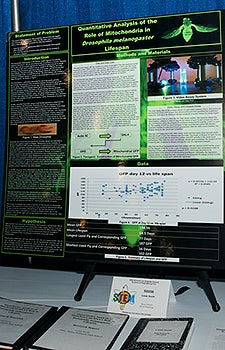Encouraging Young Scientists
As Caleb Smith watched the video of a Sudanese land mine victim using a prosthetic arm to eat unassisted for the first time in seven years, he was struck by the ability of science to fundamentally change a human life.
Smith, who just finished his junior year at Palos Verdes Peninsula High School in Los Angeles County, was participating in the Intel International Science and Engineering Fair (ISEF) May 11 to 16. The video was part of a talk given by a scientist who invented a 3D printer that could create relatively inexpensive prosthetic limbs for land mine victims.
“The story was really motivational for everyone at ISEF, showing how the science we’re working on now can be used to help other people in ways we can’t even imagine,” Smith said.
The 16-year-old wants to make a scientific impact of his own. Since the beginning of his sophomore year, he has been conducting research on aging and longevity in Professor of Biological Sciences John Tower’s laboratory at USC Dornsife. Smith recently earned the opportunity to attend ISEF held in downtown Los Angeles and present his research on tissue mitochondrial content and lifespan in Drosophila melanogaster, a species of fruit fly. At the fair he won a third place Grand Award of $1,000 in the animal sciences category for his project “Quantitative Analysis of the Role of Mitochondria in Drosophila melanogaster Lifespan.”
The findings of his research might one day give rise to a lifespan prediction model, or lead to the development of drugs that increase mitochondria content in body tissues, thereby increasing lifespan.
“I knew his research would give a good story to talk about,” Tower said. “Caleb does a great job of presenting his research and the logic behind it.”
ISEF, the world’s largest international pre-college science competition, brings together nearly 1,800 young scientists representing 70 nations to compete for accolades and $5 million in prizes. The fair is sponsored by the tech giant Intel and the nonprofit Society for Science and the Public.

Smith’s science fair poster illustrates his research on the link between mitochondria content and lifespan in fruit flies. Photo by Anne Maben.
“The best part of Intel was seeing the humanitarian impact of everyone’s research projects,” Smith said. “They all had future impact for our society, and some of them had an almost immediate impact, where scientists could use the techniques of someone my age to make a difference in their research. It was very inspirational.”
Smith qualified for ISEF after winning first place in the animal physiology category at the L.A. County Science Fair, competing with nearly 1,200 other students on March 27 to 29. He also represented L.A. County at the 2014 California State Science Fair, April 28 to 29, winning second place in the zoology category.
Smith’s research analyzed how mitochondrial abundance affects the fly’s lifespan. A cell’s mitochondria generate cellular energy. He tagged the mitochondria of 88 fruit flies with green fluorescent protein (GFP) and used cameras to gather video data on individual flies and quantify the amount of green fluorescence. His research concluded that mitochondrial quantity correlates with lifespan in Drosophila melanogaster flies.
Smith’s collaboration with Tower began about two years ago after Smith, an aspiring neurosurgeon, emailed Tower asking about possible research opportunities. Tower became interested when he learned Smith had taken a summer genetics course in the Center Scholars Program (Center for Talented Youth) at Johns Hopkins University, Tower’s alma mater.
“We had never had a high school student in our lab before, but it’s worked out very well,” said Tower. “Caleb has a wonderful attitude, he’s very inquisitive and interested in everything going on. He is always very positive about the research, which he clearly enjoys, and he’s always looking for ways to help me and other people in the lab.”
Smith has worked with Tower and Gary Landis, a research associate at USC Dornsife, on his experiments. He worked with Chaitanya Nadig, a master’s student technician from USC Viterbi School of Engineering, who taught him the video analysis component of his experiment.
“I love working with Dr. Tower and Gary because they’re both really hands-on,” Smith said. “In some labs, the leaders are always busy writing grants, but Dr. Tower won’t hesitate to work with you, even on a Sunday morning, because he cares about the success of your project even if it’s not the most major thing going on at the lab at the time. And Gary is a real teacher. He takes time to make sure you understand the concepts and are not just going through the motions.”
Tower noted that having people of different ages and at various stages in their career contributes to the lab’s atmosphere. Smith will continue his research in the Tower lab this summer and next academic year.
“I’m so grateful for the opportunity to work in the lab and for all the hours [Tower and Landis] have spent with me,” said Smith. “I came into the lab not really knowing anything about laboratory research — they’ve gotten me to where I am now and have given me a foundation for the future.”